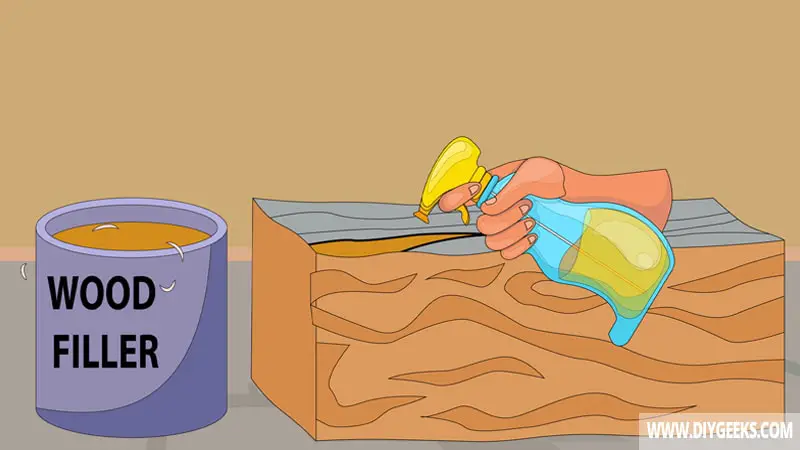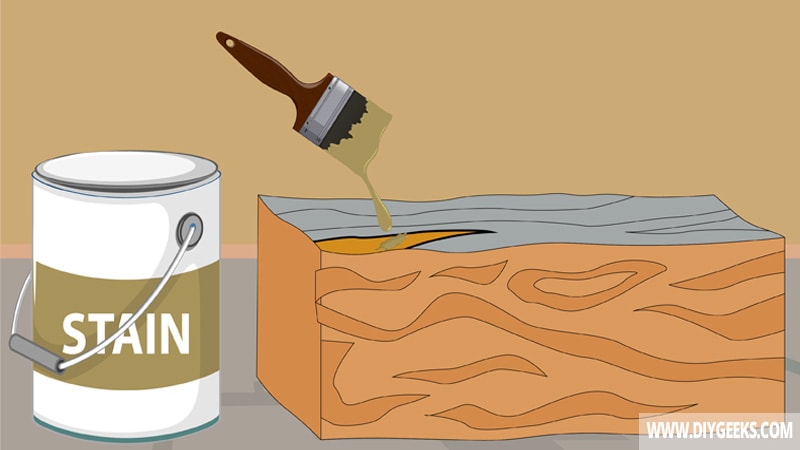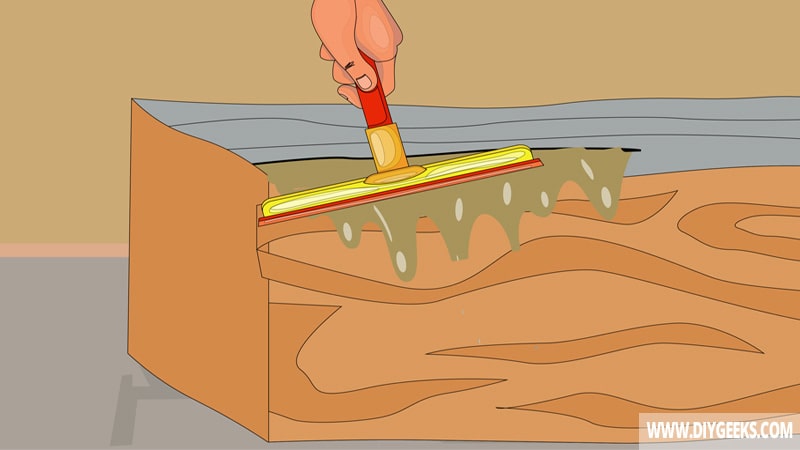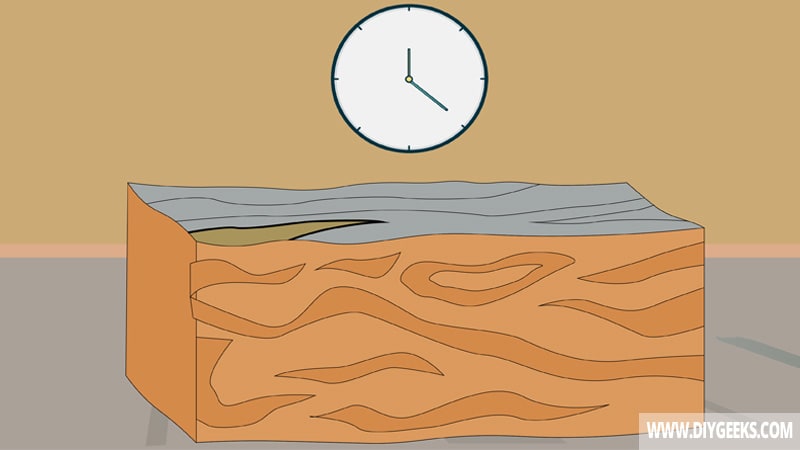Applying stain over wood filler refers to the process of filling gaps, holes, and imperfections with a filling compound, then applying a few coats of wood stain to cover the surface.
You can stain over plastic and stainable wood filler as they are made of 70% wood and absorb stain. However, you can’t stain over the normal wood filler as they are designed to be as tight as possible (non-porous) so they don’t absorb liquids well.
To stain over wood filler, sand and clean the wood filler, apply the wood stain, wipe off the excess stain, and allow the wood stain to dry.
Is Wood Filler Stainable?
Stainable wood fillers absorb stains well as they are made of porous material, including sawdust. You can make your own stainable wood filler by mixing sawdust with a binding agent, such as glue.
On the other hand, normal wood fillers are stainable, but they don’t absorb stain well as they are designed to fill and cover holes and cracks. As a result, they are designed to be as compact (or tight) as possible.
What Happens if You Apply Wood Stain over Normal Wood Fillers?
The finish will appear tacky, darker, and patchy as wood stain can’t penetrate normal wood fillers properly. Normal wood fillers aren’t porous, which makes absorbing stains difficult.
The finish will appear tacky if you stain normal wood filler as the wood stain will stay over the filling compound without penetrating it and turn sticky (remain semi-solid).
The finish will appear darker, as the wood stain is too thick to allow light to pass through and the filling compound comes pre-colored. Though its color is neutral, it still prevents the wood grain from showing.
Wood stain is designed to alter the color and reveal the wood grain. But, if a part of the surface is covered with wood filler, the grain will be covered and the spot will appear darker.
Can You Stain Plastic Wood Filler?
You can stain plastic wood fillers as they are 70% porous (in terms of composition) and are made mostly of wood.
Plastic wood filler is made of wood dust and a binder. It’s a combination of fine dust or blended wood and glue. So, plastic wood filler is more porous than normal or epoxy filler.
But, the plastic wood filler doesn’t absorb wood stains as well as stainable wood fillers. While plastic wood filler is made 70% of wood, the remaining 30% is made of glue and additives which prevent it from absorbing stains as stainable fillers do.
The finish can have differences in the color shade if you stain over plastic wood filler. It’s recommended to stir the plastic filler before applying it as it solidifies inside the can and it can be difficult to apply it without stirring first. In some cases, you must thin it.
How To Stain Over Wood Filler?
To stain over wood filler do the following things.
- Sand and Clean the Wood Filler.
- Apply the Wood Stain.
- Wipe Off the Excess Stain.
- Allow the Wood Stain to Dry.
Note: You must only apply stain over stainable fillers. If you stain non-stainable wood fillers, the finish won’t come out well and will peel off.
Stainable wood fillers that can be stained are listed below.
- Minwax Wood Filler
- Plastic Wood Filler
- Goodfilla Wood Filler
- Latex Wood Filler
The tools you need for this project are listed below.
- Fine-grit sandpaper
- Clean rags
- A wood stain
- A paintbrush or spray gun
1. Sand and Clean the Wood Filler

Sand the wood filler with fine-grit sandpaper (220-grit) to even its texture and create tiny pores that wood stain can penetrate and adhere to.
Clean the surface with TSP or warm soapy water to remove dust, debris, or dirt.
2. Apply the Wood Stain

Apply two (2) wood stain coats over the wood filler using a paintbrush or sprayer. Wait until one coat dries before applying the next one.
3. Wipe Off the Excess Stain

After applying the first wood stain coat, wait 30 minutes before you wipe the excess stain from the surface. If you don’t wipe the excess stain, the finish can turn sticky, tacky, or peel off.
4. Allow the Wood Stain to Dry

Water-based wood stain takes less than 30 minutes to dry between coats and 24 hours to cure, while oil-based wood stain takes around 1 hour to dry between coats and 48-72 hours to cure.
How to Hide Wood Filler after Staining?
To hide wood filler after staining, do the following things.
- Use Solid Stain.
- Use a Deeper Color Shade.
Wood filler shows after staining because stains are designed to be a bit transparent as they must show the wood grain once they dry. So, if you use them over a filling compound, the filler will show.
1. Use Solid Stain
Solid stains are thicker than regular stains. They have more paint pigment and color so the finish is usually more vibrant. As such, the wood filler won’t show beneath its vibrant color.
Solid stains don’t need to penetrate as deep so they will stick better. But, if you use a solid stain, it’s not just the filler that won’t show, the wood grain wouldn’t show as well.
2. Use a Deeper Color Shade
To prevent the wood filler from showing, use a dark color. Dark stain color will hide it from showing, but it will also hide the wood grain. You can also paint over the stain to hide the filler.
These methods will only prevent it from showing if you use them before applying it.
How To Fix Wood Filler Showing After Staining?
To fix wood filler showing after staining, do the following things.
- Use a Sealer.
- Apply Wood Glaze.
- Remove the Stain
1. Use a Sealer
You can prevent the wood filler from showing if you apply a colored (tinted) sealer over it.
2. Apply Wood Glaze
A wood glaze will cover the filling compound and make the finish glossy.
3. Remove The Stain
Remove the entire stain finish and apply a coating with a darker color shade to hide the wood filler.
FAQ’s
Does Wood Filler Stain The Same as Wood?
Wood filler doesn’t stain the same as natural wood. Due to its compact nature, the regular epoxy filler doesn’t allow a coating to penetrate properly.
Even stainable fillers are designed to absorb liquid, they don’t stain as well as natural wood because they are not made from 100% wood.
The filler is designed to seal, cover, and fill damages in the surface. The product is designed to fill spaces and not absorb stains. So regardless of the advertisement and branding, the filler will not stain as good.
Which Types of Wood Stain To Use Over Wood Filler?
It’s recommended to use a water-based stain over a filling compound. The water-based stain is thinner and is more likely to penetrate a filling compound.
What If Wood Filler Won’t Stain?
If wood filler won’t stain, it means it’s an unsustainable filler. However, you can try to sand it to increase its absorption rate.


